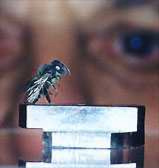
Toppan Printing Co. will exhibit a large-scale wall-sized newspaper utilizing E Ink Electronic Paper technology at EXPO 2005, which starts March 25 in Aichi, Japan. This wall-sized newspaper application is called “Yomiuri Global Newspaper – Electronic Paper”, the news will be updated twice a day. The installation consists of 272 individual tiles, a combination of an E Ink frontplane laminated onto a printed circuit board with pixel electrodes. The resulting size is is 2.2 meters by 2.6 meters. The layout is similar to an actual newspaper, the headlines and article text are displayed on monochrome Electronic Paper tiles and color photos are displayed on an LCD monitor.
-- press release, via Psysics Org
Earlier:
E Ink: Digital POP Display
E Ink: Digital Billboards
Ink: Digital Price Tags (also by Toppan)
















































